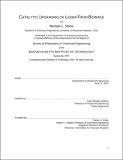Catalytic Upgrading of Lignin From Biomass
Author(s)
Stone, Michael L.
DownloadThesis PDF (8.289Mb)
Advisor
Yuriy Román-Leshkov
Terms of use
Metadata
Show full item recordAbstract
Lignocellulosic biomass is an abundant feedstock that could sustainably offset our dependence on fossil sources for carbon-based fuels and chemicals. The final hurdle to enable wide-scale success of biorefineries is the utilization of lignin, an oxygenated aromatic polymer making up 15-30% of all lignocellulose. Effective and economical lignin upgrading techniques have remained elusive, largely due to the complex structure and reactivity of lignin during processing. Broadly, my graduate work has focused on designing experiments to gain fundamental understanding while working with complex, real biomass in order to bring to light and subsequently address limitations to lignin upgrading.
Reductive Catalytic Fractionation (RCF) is a promising “lignin-first” biomass upgrading technique that extracts and depolymerizes lignin while preserving the polysaccharides as a solid residue. Using a custom-built flow-through reactor, we determined the mechanisms under which the catalyst was rapidly deactivating, we learned what factors limit rates of lignin extraction from biomass, and we began to understand how the biosynthetic production of lignin in the plant ultimately dictates the possible products that can be made through catalytic upgrading. To better elucidate the relationship between plant genetics and lignin structure, we developed a high-throughput RCF process, which will enable a genome-wide association study of poplar. Technoeconomic and lifecycle assessment of the an RCF-based biorefinery identified, among other findings, that complete utilization of RCF oil is essential to economic viability. To this end, we developed a process for near-complete utilization of RCF lignin oil through hydrodeoxygenation (HDO) to jet-range aromatics using molybdenum carbide (Mo2C) in a trickle-bed reactor. The study of neat lignin oil HDO elucidated two key findings: 1. The Mo2C surface is oxidized by neat lignin oil, necessitating higher reaction temperatures and 2. Higher temperatures result in condensation and loss of dimeric products. Using these fundamental learnings, we could achieve high yields of aromatic hydrocarbons by stabilizing the oil in a first-pass at low temperature, followed by complete conversion in the second pass at higher temperature. In total, these studies highlight the need for rigorous experiments with real biomass feedstocks to identify and address the factors that hinder biorefinery success.
Date issued
2021-09Department
Massachusetts Institute of Technology. Department of Chemical EngineeringPublisher
Massachusetts Institute of Technology